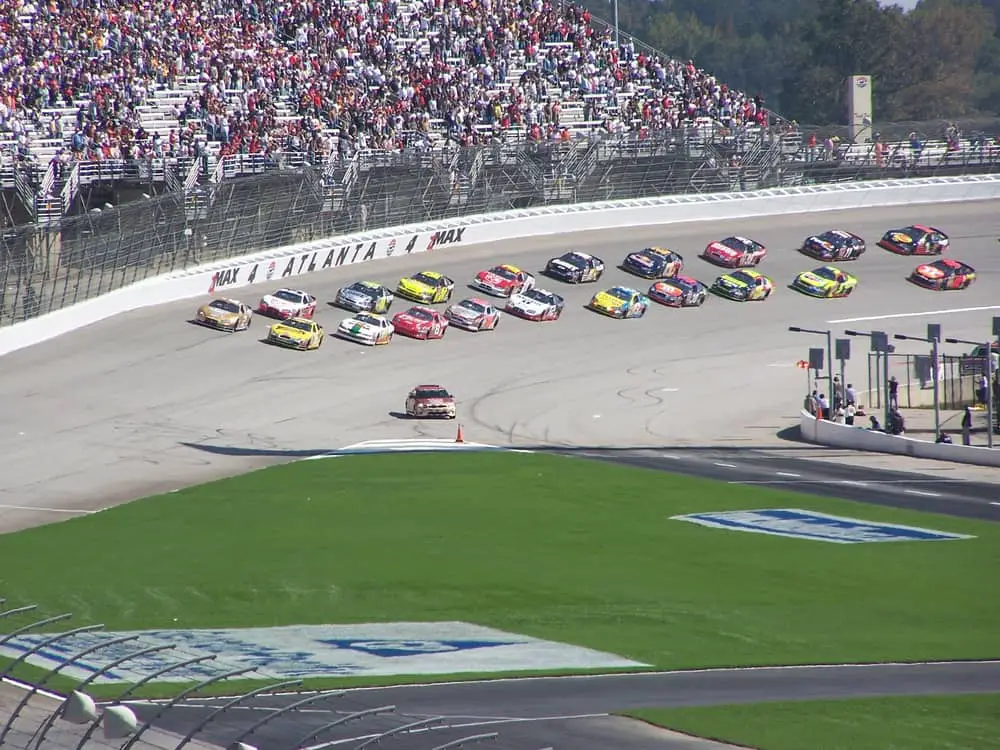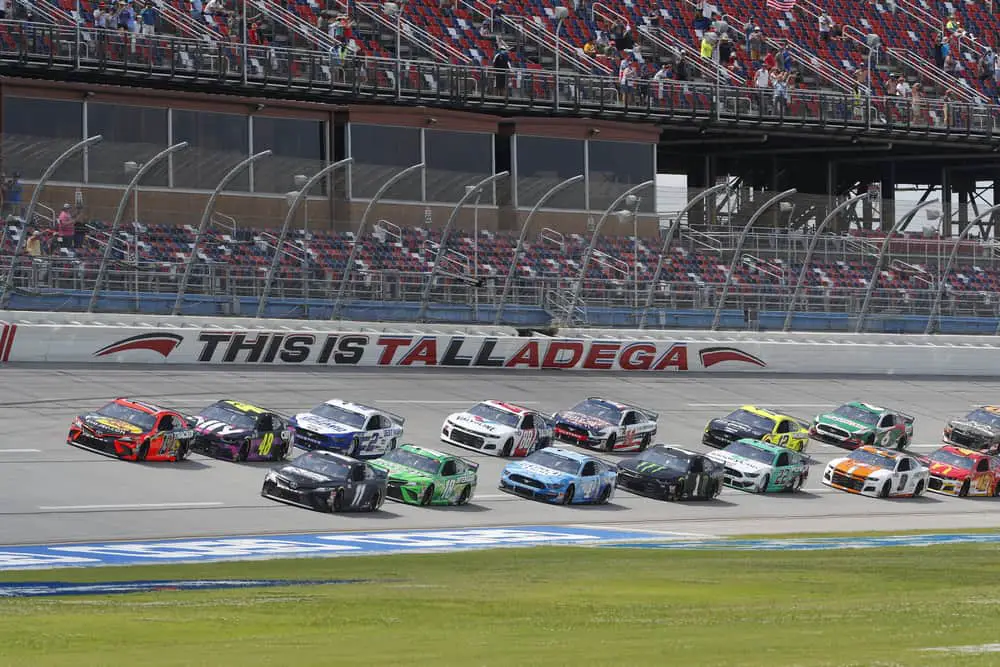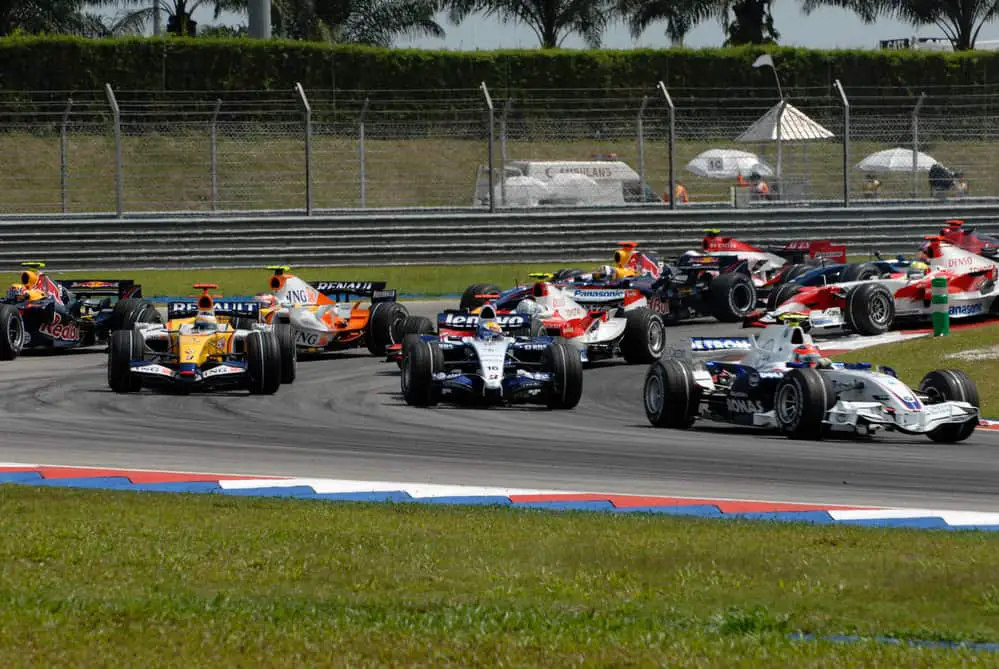If you’re unfamiliar with the world of racing, watching a 500-mile race sounds like it takes hours upon hours to complete. After all, traveling 500 miles in a car going 60 mph would take over eight hours. However, with a NASCAR race, drivers are going much faster, so the race is over much faster than you’d think. Here’s what you need to know.
How Long Do NASCAR Races Usually Last?
The length of time a NASCAR race lasts hinges on a few factors. Considering most NASCAR races are between 400 and 500 miles long, drivers usually complete the race within 2 ½ to 4 hours.
Although many races fall between 400 and 500 miles in length, there are shorter races out there. Some races, like the NASCAR All-Star Race, are as short as 75 miles in length. This particular race is usually over in less than an hour, so it’s a short race.
In addition, there are a few races that fall between 100 and 200 miles in length, including the Coke Zero Sugar 400 and the Bluegreen Vacations Duel. These races usually last less than 2 ½ hours, so they fall within the mid-range time frame.
How Long Do 500-Mile NASCAR Races Last?
The typical 500-Mile NASCAR race usually lasts about 3 ½ hours, although some can take longer than this. As mentioned, various factors can impact the length of the race, so some races might drag out for longer than others.
Stages Of A NASCAR Race
NASCAR races don’t go on continuously until drivers meet their quota of laps. Instead, the races are broken into three parts, which are referred to as stages. NASCAR introduced this concept, known as the “checkpoint system,” in 2017 to keep the race entertaining throughout its entirety.
The system awards points to the top drivers in each stage, so drivers have the opportunity to score more points in each stage. The division point varies in each race, as track lengths vary from one speedway to another.
For example, the Martinsville Speedway is a shorter racetrack, so drivers need to complete a higher number of laps. In this particular case, the race extends for 500 laps. Stage 1 ends at lap 130, Stage 2 is over at lap 260, and the final stage consists of the remaining 240 laps.
Or, look at the Daytona 500, which is comprised of 200 total laps. After 60 laps, Stage 1 is over. After another 60 laps, at lap 120 out of 200, Stage 2 ends. Lastly, Stage 3 ends after the remaining 80 laps, concluding the race.
In the first two stages, the top 10 finishers receive points. In the last stage, the same rules apply, but with an added bonus – 10 finishers receive points plus bonus Playoff points. The “stage winners,” or the leading drivers in each stage, receive Playoff points.
After tallying the Playoff points as the season wraps up, the top 10 drivers are entered into a shootout. This shootout gives the highest-scoring drivers the opportunity to win the Championship. However, since the series awards points in the middle of a race, drivers can still lose out on the championship if they perform poorly in the playoffs. This is true even if the driver takes the victory in every race throughout the regular season.
Factors That May Affect Race Length
Although the length of most NASCAR races hovers in the same ballpark, numerous factors can impact the overall length of the race. Here are a few common culprits behind extended race durations:
- Accidents: Crashes are a relatively common occurrence that delays the completion of the race. Since crashes usually leave behind small amounts of debris, cleanup teams need to remove it before the race can continue. Depending on the severity of the crash, this can take a while.
- Oil spills and fires: In some cases, oil spills after a collision can lead to fires. Even if they don’t, the spill needs to be carefully cleaned from the track, as it could create another accident due to its slippery nature.
- Barrier and catch fence damage: Although this is associated with high-impact conditions, damage to the barrier and catch fencing can lead to delays in the race. Damage to these structures can jeopardize the safety of spectators and drivers, as they create a safety barrier. So, if repairs are necessary, the race will take longer.
- Adverse weather conditions: Rain, sleet, and other adverse weather conditions can impact the duration of the race. In some cases, these conditions can push the race back several hours or reschedule it until the following day, as racing can be dangerous in these conditions.
500-Mile NASCAR Races
There are a few 500-mile NASCAR races in the bunch, each taking place on varying tracks with fluctuating lap numbers. The chart below outlines a few of the 500-mile NASCAR races and basic information about them, including average time to completion, lap numbers, and tracks.
| Name | Track | Average Time To Completion | Number of Laps | Length (miles) |
| Folds of Honor QuikTrip 500 | Atlanta Motor Speedway | 3 hours 38 minutes | 325 | 500 |
| Bank of America Royal 400 | Charlotte Motor Speedway | 3 hours 38 minutes | 334 | 501 |
| Southern 500 | Darlington Raceway | 3 hours 56 minutes | 367 | 501 |
| Daytona 500 | Daytona International Speedway | 3 hours 22 minutes | 200 | 500 |
| Autotrader EchoPark Automotive 500 | Texas Motor Speedway | 3 hours 33 minutes | 334 | 501 |
What Is The Longest NASCAR Race?
If you thought 500-mile races were long, how about a 600-mile race? The Coca-Cola 600 is the lengthiest NASCAR race for its distance of 600 miles. On average, it takes drivers approximately 4 ½ hours to complete. The race is held in Concord, North Carolina, at the Charlotte Motor Speedway.
What Is The Shortest NASCAR Race?
The shortest NASCAR race is only 37 miles long and requires 150 laps to complete. This race, the Busch Light Clash, is an exhibition race on a quarter-mile dirt track. The race takes place inside the newly-built track within the Los Angeles Memorial Coliseum.
How Much Time Do You Need To Watch A NASCAR Race?
Although the exact amount of time you’ll need to watch a full-length NASCAR race depends on the race you’re watching, you should plan for more time than the scheduled length. Various delays, including suspensions and rescheduling, can draw out the event from its projected start date.
On top of that, the varying factors affecting the race length, such as accidents, oil spills, and less-than-stellar weather conditions, could draw out or push back the total time.
So, if you’re planning on watching a NASCAR race, it’s usually best to give yourself the entire day. This way, you won’t miss out on the excitement if the race takes longer due to collisions or is delayed a few hours due to weather conditions.
Why Are NASCAR Races So Much Longer Than F1 Races?
NASCAR races are usually much longer than F1 races, sometimes more than double the time length of an F1 race. While NASCAR races can take longer than 4 hours to complete, F1 races can be no longer than 2 hours.
Aside from the factors mentioned earlier, NASCAR races can go longer due to average speeds. While drivers still whiz around the track at breakneck speeds, F1 drivers go even faster. With the added speed, F1 drivers deal with stronger G-force, which places stress on their necks. So, after a while, drivers may struggle to hold their heads up, focus on the road, or remain conscious. Because of this, F1 races cannot last any longer than 2 hours.
Frequently Asked Questions (FAQs)
How Many Cars Are There In A NASCAR Race?
In the early years of NASCAR races, there were 43 drivers competing on the track. However, in recent years (since 2016), the number has hovered at 40 drivers per race. However, only 36 spots are guaranteed to charter teams. The last four spots are available to non-charter teams, so non-charter drivers compete for the remaining spots.
How Fast Do NASCAR Cars Go?
NASCAR drivers zip around the track rapidly, going much faster than the average car. In many cases, these drivers exceed speeds over three times the average freeway speed. NASCAR cars have top speeds of around 200 mph.
However, while this is fast, these cars aren’t the fastest ones out there. Formula 1 cars are capable of speeds around 223 mph, and Indycar is even faster, reaching impressive speeds of around 236 mph.
When Is The NASCAR Season?
Although NASCAR racing might seem endless to uninterested parties, the sport follows a defined season. Although races take place throughout most of the year, there is an off-season. The sport’s defined season extends from February and finishes in November, with 38 races scattered throughout those ten months. The off-season extends through December and into January.
Where Are NASCAR Races Held?
NASCAR races are held at a variety of tracks, depending on the race. There are four length categories for the tracks where these races are held, including short track, intermediate, road course, and superspeedway.
The longest oval-shaped NASCAR tracks are held at superspeedway race tracks. Generally, well-known tracks host superspeedway races, such as Daytona, Indianapolis, and Talladega. These tracks are lengthy at over 1.5 miles in length, so there are usually fewer laps involved.
Do NASCAR Races Ever Stop Mid-Race?
There are various scenarios where a NASCAR race might stop mid-race. For example, if there’s inclement weather that moves in suddenly or the track requires extensive repairs, the situation may call for a red flag.
In these particular scenarios, the drivers can leave their cars to use the facilities, eat a meal, and so on. This gives drivers a break while they wait for the weather to blow over or the track to be repaired.




